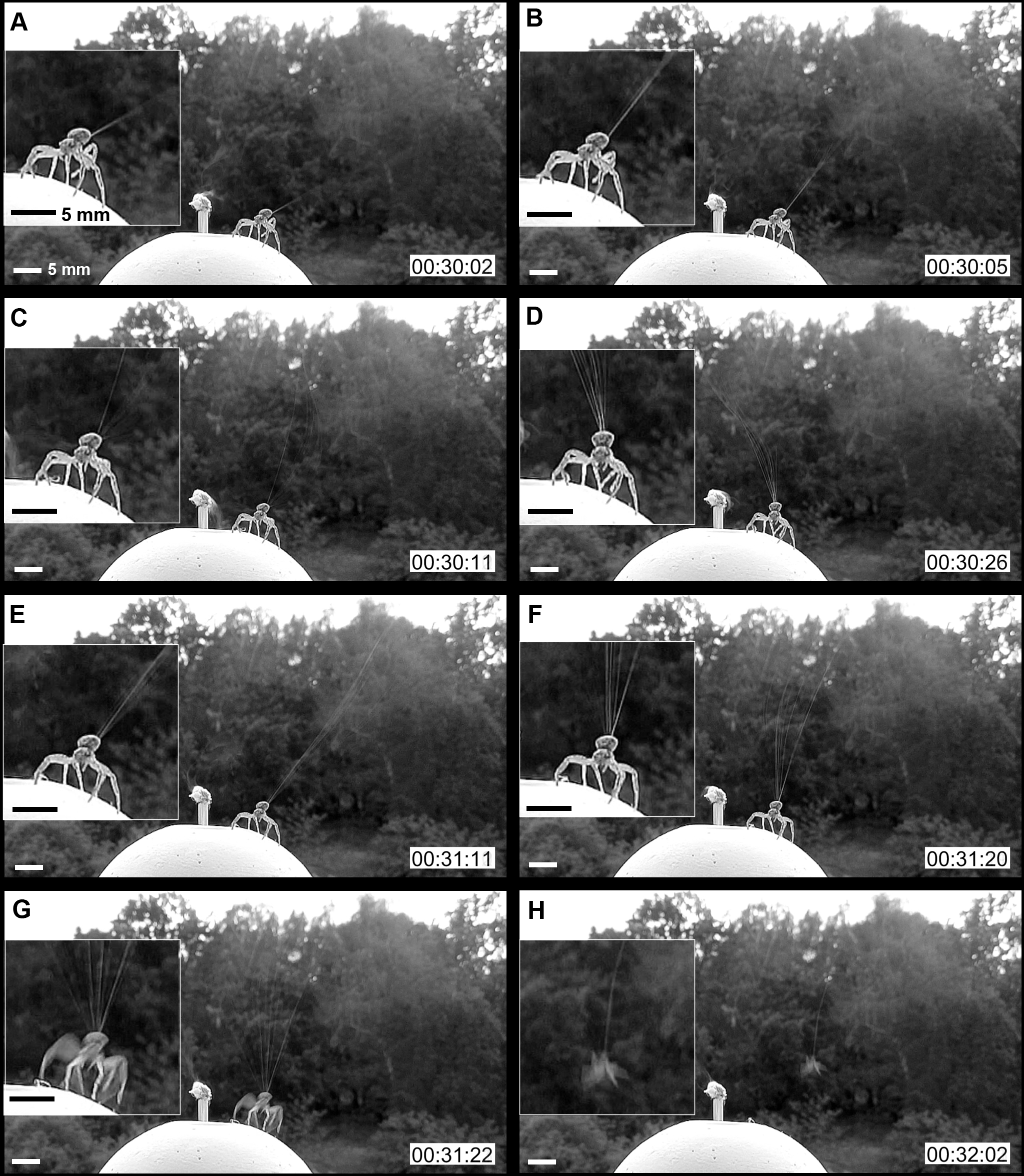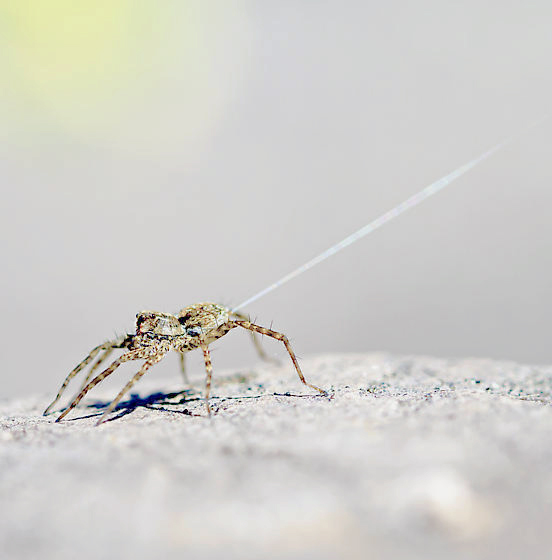Ballooning (spider) on:
[Wikipedia]
[Google]
[Amazon]

 Ballooning, sometimes called kiting, is a process by which
Ballooning, sometimes called kiting, is a process by which
 In Australia, in 2012 and in May 2015, millions of spiders were reported to have ballooned into the air, making the ground where they landed seem snow-covered with their silk.
In Australia, in 2012 and in May 2015, millions of spiders were reported to have ballooned into the air, making the ground where they landed seem snow-covered with their silk.
 Most ballooning journeys end after just a few meters of travel, although depending on the spider's mass and posture, a spider might be taken up into a jet stream. The trajectory further depends on the
Most ballooning journeys end after just a few meters of travel, although depending on the spider's mass and posture, a spider might be taken up into a jet stream. The trajectory further depends on the

 Ballooning, sometimes called kiting, is a process by which
Ballooning, sometimes called kiting, is a process by which spider
Spiders ( order Araneae) are air-breathing arthropods that have eight legs, chelicerae with fangs generally able to inject venom, and spinnerets that extrude silk. They are the largest order of arachnids and rank seventh in total species ...
s, and some other small invertebrate
Invertebrates are a paraphyletic group of animals that neither possess nor develop a vertebral column (commonly known as a ''backbone'' or ''spine''), derived from the notochord. This is a grouping including all animals apart from the chordate ...
s, move through the air by releasing one or more gossamer threads to catch the wind, causing them to become airborne at the mercy of air currents and electric fields. A 2018 study concluded that electric fields provide enough force to lift spiders in the air, and possibly elicit ballooning behavior. This is primarily used by spiderlings to disperse; however, larger individuals have been observed doing so as well. The spider climbs to a high point and takes a stance with its abdomen to the sky, releasing fine silk threads from its spinneret
A spinneret is a silk-spinning organ of a spider or the larva of an insect. Some adult insects also have spinnerets, such as those borne on the forelegs of Embioptera. Spinnerets are usually on the underside of a spider's opisthosoma, and a ...
until it becomes aloft. Journeys achieved vary from a few metres to hundreds of kilometres. Even atmospheric samples collected from balloons at five kilometres altitude and ships mid-ocean have reported spider landings. Ballooning can be dangerous (due to predators, and due to the unpredictable nature of long-distance ballooning, which may bring individuals to an unfavorable environment).
It is observed in many species of spider
Spiders ( order Araneae) are air-breathing arthropods that have eight legs, chelicerae with fangs generally able to inject venom, and spinnerets that extrude silk. They are the largest order of arachnids and rank seventh in total species ...
s, such as '' Erigone atra'', ''Cyclosa turbinata
''Cyclosa turbinata'' is a species of orb weaver belonging to the family of spiders known as Araneidae. It is found in a range from the United States to Panama, West Indies, Galapagos Islands, and has been introduced into Hawaii.
Geographic Loc ...
'', as well as in spider mites ('' Tetranychidae'') and in 31 species of lepidoptera, distributed in 8 suborders. Bell and his colleagues put forward the hypothesis that ''ballooning'' first appeared in the Cretaceous. A 5-year-long research study in the 1920s–1930s revealed that 1 in every 17 invertebrates caught mid-air is a spider. Out of 28,739 specimens, 1,401 turned out to be spiders.
Description
Ballooning is a behaviour in which spiders and some other invertebrates use airborne dispersal to move between locations. A spider (usually limited to individuals of a small species), or spiderling after hatching, will climb as high as it can, stand on raised legs with its abdomen pointed upwards ("tiptoeing"), and then release several silk threads from itsspinnerets
A spinneret is a silk-spinning organ of a spider or the larva of an insect. Some adult insects also have spinnerets, such as those borne on the forelegs of Embioptera. Spinnerets are usually on the underside of a spider's opisthosoma, and are ...
into the air. These automatically form a triangular shaped parachute which carries the spider away on updrafts of winds where even the slightest of breezes will disperse the arachnid. The Earth's static electric field may also provide lift in windless conditions. Ballooning behavior may be triggered by favorable electric fields.
Many spiders use especially fine silk
Silk is a natural protein fiber, some forms of which can be woven into textiles. The protein fiber of silk is composed mainly of fibroin and is produced by certain insect larvae to form cocoons. The best-known silk is obtained from the ...
called ''gossamer'' to lift themselves off a surface, and silk also may be used by a windblown spider to anchor itself to stop its journey. The term "gossamer" is used metaphor
A metaphor is a figure of speech that, for rhetorical effect, directly refers to one thing by mentioning another. It may provide (or obscure) clarity or identify hidden similarities between two different ideas. Metaphors are often compared wi ...
ically for any exceedingly fine thread or fabric. Biologists also apply the term "balloon silk" to the threads that mechanically lift and drag systems.
It is generally thought that most spiders heavier than 1 mg are unlikely to use ballooning. Because many individuals die during ballooning, it is less likely that adults will balloon compared to spiderlings. However, adult females of several social ''Stegodyphus
''Stegodyphus'' is a genus of velvet spiders that was first described by Eugène Simon in 1873. They are distributed from Africa to Europe and Asia, with one species (''S. manaus'') found in Brazil. The name is derived from Ancient Greek ('' st ...
'' species (''S. dumicola'' and ''S. mimosarum'') weighing more than 100 mg and with a body size of up to have been observed ballooning using rising thermal
A thermal column (or thermal) is a rising mass of buoyant air, a convective current in the atmosphere, that transfers heat energy vertically. Thermals are created by the uneven heating of Earth's surface from solar radiation, and are an example ...
s on hot days without wind. These spiders use tens to hundreds of silk strands, which form a triangular sheet with a length and width of about .
 In Australia, in 2012 and in May 2015, millions of spiders were reported to have ballooned into the air, making the ground where they landed seem snow-covered with their silk.
In Australia, in 2012 and in May 2015, millions of spiders were reported to have ballooned into the air, making the ground where they landed seem snow-covered with their silk.
Distance and height achieved
 Most ballooning journeys end after just a few meters of travel, although depending on the spider's mass and posture, a spider might be taken up into a jet stream. The trajectory further depends on the
Most ballooning journeys end after just a few meters of travel, although depending on the spider's mass and posture, a spider might be taken up into a jet stream. The trajectory further depends on the convection
Convection is single or multiphase fluid flow that occurs spontaneously due to the combined effects of material property heterogeneity and body forces on a fluid, most commonly density and gravity (see buoyancy). When the cause of the conve ...
air currents and the drag of the silk and parachute to float and travel high up into the upper atmosphere Upper atmosphere is a collective term that refers to various layers of the atmosphere of the Earth above the troposphere and corresponding regions of the atmospheres of other planets, and includes:
* The mesosphere, which on Earth lies between th ...
.
Many sailors have reported spiders being caught in their ship's sails over from land (Heimer 1988). They have even been detected in atmospheric data balloons collecting air samples at slightly less than above sea level. Evidently, ballooning is the most common way for spiders to invade isolated islands and mountaintops. Spiderlings are known to survive without food while travelling in air currents of jet streams for 25 days or longer.
Some mite
Mites are small arachnids (eight-legged arthropods). Mites span two large orders of arachnids, the Acariformes and the Parasitiformes, which were historically grouped together in the subclass Acari, but genetic analysis does not show clear e ...
s and some caterpillars also use silk to disperse through the air.
A close association has been found between ballooning behaviors and the ability for a species of spiders to survive afloat on water. Water-repellent legs keep them alive on both fresh and salt water, enabling them to survive waves up to 0.5 metres in height. In wind many species raised their legs or abdomens to use as sails, propelling themselves across the water's surface. Many species of spiders also drop silk to anchor themselves in place while afloat. Said spiders did not show these behaviours on land, suggesting that they are adaptations to water.
History
Although this phenomenon has been known since the time of Aristotle, the first precise observations were published by thearachnologist
Arachnology is the scientific study of arachnids, which comprise spiders and related invertebrates such as scorpions, pseudoscorpions, and harvestmen. Those who study spiders and other arachnids are arachnologists. More narrowly, the study of ...
John Blackwall
John Blackwall (20 January 1790 – 11 May 1881) was an English naturalist with a particular interest in spiders.
Life
Blackwall was born in Manchester on 20 January 1790. He lived at Hendre House near Llanrwst in north Wales from 1833 until ...
in 1827. Several studies have since made it possible to analyze this behavior. One of most important and extensive studies exploring ballooning was funded by U.S. Department of Agriculture
The United States Department of Agriculture (USDA) is the federal executive department responsible for developing and executing federal laws related to farming, forestry, rural economic development, and food. It aims to meet the needs of comme ...
and performed between 1926 and 1931 by a group of scientists. The findings were published in 1939 in a 155-page bulletin compiled by P. A. Glick.
See also
*'' Charlotte's Web'' *Aeroplankton
Aeroplankton (or aerial plankton) are tiny lifeforms that float and drift in the air, carried by wind. Most of the living things that make up aeroplankton are very small to microscopic in size, and many can be difficult to identify because of ...
*" A Noiseless Patient Spider", a poem by Walt Whitman based on spider ballooning behaviour
*Organisms at high altitude
Organisms can live at high altitude, either on land, in water, or while flying. Decreased oxygen availability and decreased temperature make life at such altitudes challenging, though many species have been successfully evolutionary adaptation, ...
*Spider silk
Spider silk is a protein fibre spun by spiders. Spiders use their silk to make webs or other structures, which function as sticky nets to catch other animals, or as nests or cocoons to protect their offspring, or to wrap up prey. They can ...
*'' To Demonstrate How Spiders Fly'', documentary short film
References
Further reading
* * (1988): Wunderbare Welt der Spinnen. ''Urania-Verlag Leipzig''. . {{Ethology Arachnology Ethology Articles containing video clips Gliding animals